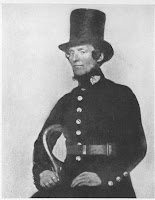 |
| Sir Robert Peel - 224 years old today! |
Living in Tamworth it’s hard to avoid Sir Robert Peel, founder of the Metropolitan Police Force, who served two terms of office as Prime Minister, and developed a pig which was named after the town. Peel, who represented Tamworth in Parliament, is also known for repealing the Corn Laws, laying the foundations of the modern Conservative Party, and building a stately pile at Drayton Manor – now the site of a theme park.
Today is his birthday: he was born in Bury in 1788, which makes him 224. Should you wish to mark the occasion I would suggest cakes, buns or biscuits would be highly suitable, given the link with Corn Laws. You could, of course, cook pork, or ham, or bacon but, as a vegetarian, I’m not sure I should encourage you to eat meat. Come to that, I’m not sure I should encourage anyone to celebrate the birth of a Tory politician, but he is an interesting historic figure.
Anyway, back to more serious matters. By the early 1790s the Peels had moved from Lancashire to Staffordshire, where they set up home in an old manor house at Drayton Bassett, just outside Tamworth. The future PM’s grandfather had made a fortune printing calico cloth with coloured designs, including a popular parsley leaf pattern which earned him the nickname Parsley Peel. Once in Tamworth the family continued to print fabric, and also established a cotton mill in the town. In addition they rented the historic Castle and installed a forge in the Great Hall – a form of industrial vandalism which seems to have bothered no-one at the time.
 |
| Tamworth Pigs, said to have been bred by Sir Robert Peel, are known as Sandybacks because of their reddinsh sndyish colour. |
 |
| A 'Peeler' pictured roundabout 1850 |
He became Home Secretary in 1822, and his best known initiative from that period was the founding of the Metropolitan Police Force in 1829 – the officers were nicknamed Peelers, or Bobbies, a term still in use today. However, he was also responsible for overhauling criminal laws; introduced a proper system of payment for jailers; made for provision for the education of prisoners, and cut the number offences which carried the death penalty.
After a period in opposition, in December 1834 Sir Robert Peel drew up the Tamworth Manifesto (which, according to legend, was read to the people from a window in the Town Hall). This document outlined the actions he hoped to take. It was the first time a politician had pledged his policies so openly, and established a procedure which is still being followed by modern political leaders. It is also regarded as the point at which the Tories began the journey that eventually resulted in the creation of the Conservative Party. Peel became Prime Minister, but he led a minority Government and held the position for just a few months, resigning in April 1835, when the Whigs seized control.
 |
| I took this photo of Tamworth's Perl Statue because I liked the showy cape and cap. |
Four years later Queen Victoria asked him to form a Government, prompting what became known the Bedchamber Crisis. Peel, concerned that many of the Queen’s Ladies were the wives and daughters of prominent Whigs, asked for some of them to be replaced with Tory supporters, but the Queen rejected the idea – so Peel refused to form a Government. However, in 1841 the Tories were back in power and he was Prime Minister for the next five years.
In 1848, supported by Whigs and Radicals – but not by his own party - he repealed the Corn Laws, which were originally introduced to safeguard the livelihoods of British farmers and landowners. It is often claimed that he took this action so more food would be available for victims of the Irish potato famine, but it is also possible that he supported free trade At any rate, the decision led to his resignation, and overshadowed his other legislation, including acts which stopped women and children working underground, and limited the length of time they could work in factories.
Peel and his wife Julia had five sons and two daughters and lived at Drayton Manor, the stately home he built on the site of the old manor house in the early 1930s. It was very fashionable, very modern, and had the best of everything – including a central heating system which was admired by Queen Victoria when she stayed there with Prince Albert in 1843. Sadly, the house stood for less than a century and was demolished in 1929, and today only the clock tower remains.


No comments:
Post a Comment
Thank you for commenting on my blog. I love to hear from readers.